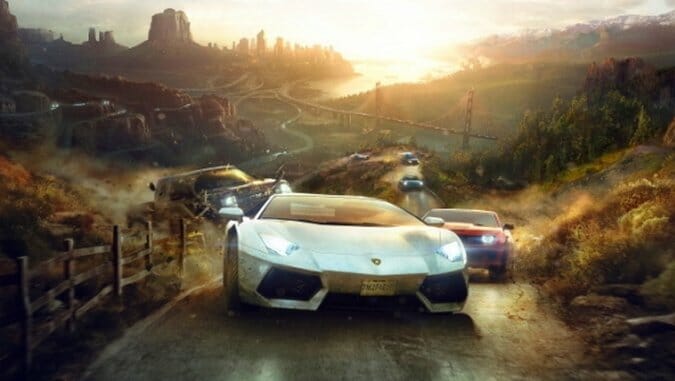The Crew: Postcard America

It feels like, at some point during The Crew’s development, its designers lost sight of the fact that people like to drive. Not just to race or to bash through crates or to launch from jumps, but to drive. People like those other things too, of course, but underlying those joys is a more fundamental one: People like to move, to travel, to drive. Unfortunately, The Crew is not a good game for driving. I didn’t realize that right away though. On my first night with The Crew, once I was done with the tutorial missions, I decided to travel from Detroit to New York, and then down home to Jersey—or at least to the approximation available in this strange pastiche America. I put on a podcast. I drove.
I passed through so many little places, the sort we all have in the periphery of our lives. This is when The Crew is at its best. It so easily captures the grimy little motel off the side of the highway that you crashed at that night. Or the little café, with that patio that you remember so well, but that you can’t actually remember stopping at. Or that little park with the statue of… um, you know, that guy? These towns are filled with low resolution assets and weird architectural arrangements, but somehow that makes them more familiar. Whether they intended to or not, Ubisoft captured the way small towns, strange signs, and old highways feel in my memory. Hours slipped away.
The big cities I passed through didn’t feel as good as the spaces in between. They were cramped, desperate to show off landmarks. But still, that first night I thought I was going to love The Crew. It had given me something no other game had: A sort of Postcard America. The kind of virtual tourism I could feel good about. The open road. Little sketches of little places. The warm feeling you get when you “discover” a quaint little town, but with none of the awkwardness of being an outsider.
But by the end of my time with it, I realized that I hated The Crew. There’s so little in its structure to encourage the sort of aimless wandering that I loved that first night. The driving model, which was perfectly fine for quiet exploration, fell apart when applied to the campaign’s missions. Those missions (and the laughable cutscenes that stitched them together) were a burden I couldn’t wait to be done with. And the game’s difficulty curve and progression system encouraged me to fast travel from event to event, grinding so I could get the upgrades I needed, and missing out on all those interesting places. Most of all, though, it made me realize that I didn’t want a Postcard America at all.
The Honeymoon’s Over
Like every other recent Ubisoft release, The Crew is stuffed with a huge array of activities: Story missions guide you through the life of Alex Taylor, an ex-con turned undercover cop out for revenge. Faction events offer asymmetrical PVP, with your race times and mission performance adding to your team’s score. Skill missions dot the roads, testing your driving ability through various mini-games and awarding you with new car parts. These are added to your map naturally as you explore, or you can add them in bulk by finding and approaching the satellite dishes (which serve as The Crew’s small variation of the “synchronization towers” common to Ubisoft’s ur-design) and once they’re added you can fast travel right to them.
As Alex Taylor, you’re tasked with infiltrating the 510s, a country-wide gang that does ambiguous crime stuff and organizes itself around a hierarchy of skilled drivers. The Crew so clearly wants to evoke the frenetic chase scenes of The Fast and the Furious, but it never really comes close. Every mission fits into a handful of types, so the whole thing ends up feeling formulaic. Sometimes you bash through 80 crates in Nebraska. Sometimes you bash through 80 crates in Nevada. Sometimes a plane or a helicopter will take a really low route across the skyline; not because it’s connected to the mission, but because it’s a cheap way to inject a feeling of speed and scope into the missions. And unlike The Fast and the Furious, there’s none of that Vin Diesel charisma here: Alex Taylor and his “crew” are flat archetypes. If you listen closely, you can even hear the resignation in their voices.
The other reason that The Crew falls short of Hollywood spectacle is that it clings to the ambiguity of what exactly you’re doing. Since you’re working undercover most of the missions you do involve some sort of criminal activity, but there’s rarely any sort of specificity. And there’s never any real human cost. You smuggle things, sure, but you promise “never to smuggle anything dangerous.” Cop cars stutter to a stop, but they never explode. The number one crime you’ll commit—literally the only thing that will draw the ire of the police—is the destruction of fences. The Crew is an action film that only ever airs on TBS, with a zero body count, and all of the curse words dubbed over. The Crew is Postcard America.
This Year’s Power Fantasy
As you travel from one campaign mission to the next, you’re theoretically meant to play through the “skill missions” that dot the highways. They neatly layer over the road, and test your ability to control your car, take jumps, or navigate tricky routes. On paper, they’re a great way to encourage the sort of exploration I loved that first night. Unfortunately, the The Crew’s difficulty curve and progression system encourages you to quickly fast travel from event to event, from skill game to skill game, cutting up the game’s impressive world into boring little chunks.
These events lock into a progression system to encourage players to gorge themselves on this buffet of content. As you play through events you gain experience points and new car parts. Leveling up nets you bonuses to your driving stats, discounts to shops, and other benefits. Pretty standard stuff. The parts system, on the other hand, is the most insidious design to come out of one of Ubisoft’s many dev houses.
-

-

-

-

-

-

-

-

-

-

-

-

-

-

-

-

-

-

-

-

-

-

-

-

-

-

-

-

-

-

-

-

-

-

-

-

-

-

-

-









































